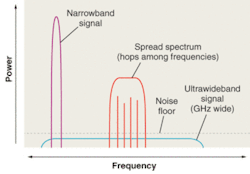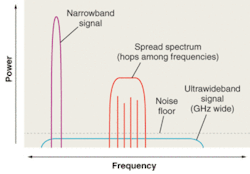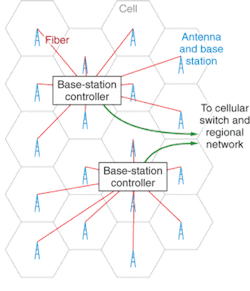Fiber and wireless face off
The strengths of fiber and wireless are different, so while they are complementary in some markets, they compete in others. The marketplace is striking a balance between them to take advantage of their natural niches.
On the surface, fiberoptic and wireless communications seem on a collision course. Wireless is the healthiest part of a telecommunications industry still nursing the hangover from the bubble. Voice traffic is shifting to cell phones, and some cell-phone users are going entirely mobile, dropping their landline phones. Home and office computer users are shifting to wireless computer networks to avoid the tangled mass of cables. Fixed wireless systems can provide point-to-point or point-to-multipoint communications. Wireless developers herald advantages over cables including quicker installation, lower installation cost, and the flexibility of relocation.
Yet the story is more complex than head-to-head competition for the same markets because fiber and wireless have different strengths and natural market niches. Fiber offers tremendous bandwidth and low attenuation, giving it a lock on long-distance terrestrial and submarine transmission in the backbone of the global telecommunications network. Wireless has a lock on mobile communications because it avoids the need for physical connections. The battleground between the two is a more limited range of applications-shorter connections at moderate speeds between points where mobility is not critical. That’s still a big market with diverse needs.
Wireless technology
Wireless has come to mean any technology that transmits signals without cables, wires, or waveguides. Radio frequency and microwave transmission are the most common, but free-space optical systems are also called wireless. Radio frequency and low-frequency microwave signals broadcast in all directions, making them best suited for point-to-multipoint communications. The shorter wavelengths of high-frequency microwaves allow them to be transmitted in a narrower range of angles, so they, like free-space optics, can be used for point-to-point links.
Mobile applications such as cellular phones and Wi-Fi wireless data networks depend on broadcast signals. The signals physically reach all terminals within reception range, but are encoded so only a particular receiver decodes them. Other services are based on directional transmission, with the width of the beam depending on the locations of subscribers. Satellite television transmitters beaming to subscribers on the ground have a wider range than free-space optics beaming to a building 500‑m away. Regulatory agencies such as the Federal Communications Commission in the United States require licensing of transmitters in many frequency bands, such as the radio and television broadcast bands, but leave some bands open for unregulated transmission.
Reception range depends on transmitter power, beam angle, attenuation at the signal frequency, and local conditions. Buildings and local topography can create dead zones that block cell-phone reception, and cause multipath effects that create ghosts on television screens. Weather also affects transmission, particularly at high frequencies that “see” precipitation. It’s worth remembering that the original selling point of cable television was better reception than available over the air.
Conventional radio signals are produced by amplitude or frequency modulation of a carrier frequency, which concentrates the signal in a limited-frequency band. Ultrawideband technology instead spreads the signal across a wide range of frequencies (see Fig. 1). This allows weak ultrawideband signals to be transmitted in bands used for conventional signals, although the power must be limited to prevent interference.
Cellular phones
The cellular phone network distributes signals through a network of transmitting antennas serving local areas or “cells.” Ideally, the cells should be spaced to cover the entire area (see Fig. 2). Base transceiver stations at each antenna process signals, and relay them to a base-station controller, which handles signals from a number of cells, and links them to a switching center that switches the calls and provides interfaces to regional and global phone networks, like a central office in a conventional wire-line phone system.
Although individual phones are mobile, the network of towers, base stations, controllers, and switches that serves the phones is fixed, and requires point-to-point backhaul connections to the regional phone network. First-generation analog cell phones carried signals in standard telephone formats, so the standard approach was to lease land phone lines to serve the base stations; usually a single 1.5-Mbit/s T1 phone line would suffice. The now-standard second-generation (2G) cell phones use digital transmission and circuit switching as in the standard wire-line phone network. Newer 2.5G and 3G phones use more bandwidth, offer extra services, and rely on packet switching like the Internet.
Fiber and wireless systems compete for backhaul applications. Fiber offers bandwidth and reliability, but fixed directional wireless can be cheaper and faster to install depending on the local environment. In practice, the choice is affected by the ownership as well as the availability of phone lines, because some cellular carriers are owned by regional phone companies.
Wireless local-area networks
Wireless local-area networks have become popular for computer Internet access, with Wi-Fi (for Wireless Fidelity) the dominant technology. Based on the IEEE 802.11 family of standards, Wi-Fi devices are widely available. They operate over short distances in radio bands that don’t require licenses, with the most common types in the 2.4-GHz band shared with microwave ovens and other unlicensed short-distance links such as Bluetooth. Other Wi-Fi devices can operate in the 900-MHz or 5-GHz bands. Typically operation is limited to between 15 and 50‑m indoors with somewhat longer distances possible outdoors.
Like cell-phone base stations, Wi-Fi base stations collect signals from mobile terminals and transmit them to the fixed network. The link can be cable or wireless, with the WiMAX systems described below the leading wireless option. Wi-Fi spreads the signal across a moderately wide band using spread-spectrum techniques.
WiMAX and fixed wireless
The Worldwide Interoperability for Microwave Access (WiMAX) standard covers a broad family of wireless metropolitan-area networks based on IEEE 802.16 standards. The standard is designed as an umbrella to promote interoperability and it can be implemented in many ways, so descriptions can be confusing to those used to detailed and specific standards. The basic IEEE 802.16 standard, for example, covers frequencies of 10 to 66 GHz, and the IEEE 802.16a standard covers 2- to 11-GHz frequencies, but individual systems would operate in limited-frequency bands. Likewise, the signaling format allows service at up to 50‑km from the base station, but that distance can be realized only with high transmitter power at lower frequencies. Individual systems will be designed within that framework to meet local restrictions, such as transmitting within locally available frequency bands.
The broad goals for WiMAX are to link a fixed base station to fixed and mobile terminals in a metropolitan area, but initial efforts have focused on fixed terminals (see Fig. 3). Like a cellular base station, a WiMAX base station would “see” all terminals to the limit of its operating range, although antennas could be restricted to sectors of 60° or 90° instead of being omnidirectional. One application is to provide wireless backhaul from Wi-Fi base stations. Another is as an alternative to DSL and cable modems for broadband Internet connections. WiMAX lacks the bandwidth for broadcasting many video channels, so it is not likely to compete with cable television. However, it can allocate fixed capacity to individual users, so it could provide the equivalent of leased telephone-line service to customers in the area.
Two other families of wireless systems also can distribute signals to individual subscribers: LMDS (local multipoint distribution systems) and MMDS (multichannel multipoint distribution systems). Although the names sound similar, the designs, capabilities, and markets differ.
An LMDS base station transmits up to 5 miles (8 km) in a series of bands between 28 and 31 GHz in the United States. Base stations connect to a fiberoptic backbone system and transmit signals to multiple subscriber terminals. The service can offer high bandwidth, and carry voice, video, and data services. It can distribute signals to business subscribers, but a major interest has been in distribution to residential subscribers. The distribution network includes only terminal equipment, so there is no need to lay cables, or to install terminals in homes that don’t subscribe to the service. However, transmission can be a problem because 30-GHz transmission requires a clear line of sight for good reception.
The MMDS has a similar architecture, but operates in a lower-frequency band, 2.5 to 2.7 GHz in the U.S. Air transmits these frequencies better than the higher LMDS frequencies, but the overall bandwidth is limited to 200 MHz, the equivalent of 33 6-MHz video channels. That’s only about a third of the capacity of state-of-the-art cable television networks, limiting the use of MMDS in major markets.
Fixed wireless systems have found applications outside major markets, such as delivering broadband communications to sparsely populated rural areas. Developing countries have turned to them to connect population centers, especially in areas with little or no cable infrastructure. Fixed wireless also can provide an independent broadband service in areas where cable modems and DSL are unavailable.
Most fixed wireless systems continue to rely on radio or microwave transmission, but free-space optics have found some niches in point-to-point and mesh distribution.
Balancing technologies
New wireless and fiber technologies offer a rich mix of possibilities, and the marketplace is slowly striking a balance among them in the steadily growing market for telecommunications. Fiber is secure in the high-capacity long-haul backbone network, where satellites have been reduced to a few specialized niches. Likewise, wireless is secure in mobile communications. The real competition is in fixed distribution and access networks, where both fiber and wireless systems are viable contenders.
Verizon, SBC Communications, and BellSouth have put their considerable weight behind fiber to the premises for the residential market. The big phone companies believe that their future depends on being able to offer a “triple play” of voice, video, and data services. Wireless can carry voice and data, but fiber allows the addition of a hundred channels of video. Today’s terrestrial wireless technology can’t do that reliably. Direct broadcast satellites can, but it’s hard for them to deliver local services.
The tough competition will come in applications in which both technologies can do the job, such as metropolitan-area networks and access to remote sites. There the choice will come down to cost-performance tradeoffs, with wireless technology offering lower installation costs and fiber promising higher performance. That’s the kind of technological horse race that drives innovation.
ACKNOWLEDGMENTS
The author would like to thank Rich Mack of KMI and Roger B. Marks at the National Institute of Standards and Technology for their assistance in preparing this article.



